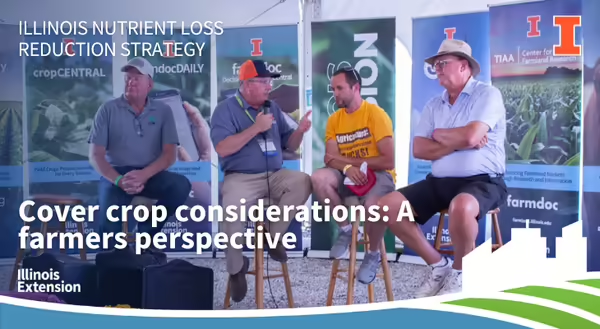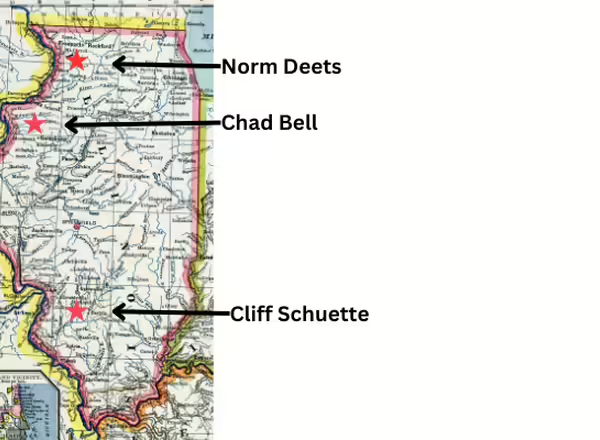
In a recent conversation held at the Farm Progress Show, three farmers spanning the state – Norm Deets, Chad Bell, and Cliff Schuette – gathered to discuss their experiences utilizing cover crops and other agricultural conservation practices. As they shared their insights, a common theme emerged: the vital importance of cover crops in promoting soil health and reducing erosion.
The farmers
Norm Deets is from Milledgeville, located in northwestern Illinois, and primarily grows corn, soybeans, and alfalfa. Chad Bell operates in Viola, located in west central Illinois. His farm includes corn, soybeans, wheat, and includes a sizable hog operation. Cliff Schuette's farm is located 40 miles east of St. Louis in southern Illinois. In addition to working with his sons on their own farm, Cliff also runs a cattle operation and has been involved in the seed business for over three decades.

Nutrient loss and erosion control
With their diverse backgrounds, the farmers emphasized the necessity for controlling soil erosion and managing nutrient loss across their respective landscapes. Cliff Schuette's journey into conservation practices began over two decades ago when he started raising forages for cattle. He witnessed firsthand the benefits of reduced nutrient loss and improved soil health. Chad Bell echoed the sentiment, explaining that his journey into cover crops began in 2012 when he grew tired of filling ditches every spring to prepare for planting. Recognizing that stopping soil erosion also helps retain vital nutrients on their land, both farmers embraced conservation practices to address these challenges.
Cover crop considerations
The discussion also included the farmers explaining some lessons they have learned throughout the years. Norm highlighted the transition he made from traditional no-till farming to incorporating cover crops into his practices, revealing how cover crops, especially cereal rye, helped mitigate the erosion issues he faced, particularly after harvesting soybeans. He learned that cover crop planting timing is crucial. In 2022 Norm aerial seeded cereal rye into his corn earlier in the season. After initially thinking the seeding was a failure, it later turned out to provide a good stand. Looking ahead, he plans to delaying planting until after the corn reaches the black layer stage allows for better growth and sunlight utilization.
Diverse cover crop mixes
Cliff Schuette emphasized the importance of using diverse cover crop mixes to enhance soil health. Rather than relying on monocultures, he has shifted toward three to six-way cover crop mixes. His approach prioritizes soil biology, which can help improve
-
aggregation
-
infiltration
-
biodiversity
-
residue decomposition
-
storage and release of nutrients, and
-
nitrogen and carbon cycling.
Schuette has found this improved soil biology has allowed him to reduce his reliance on traditional erosion control measures like grassed waterways and terraces.
Cover crop challenges
The conversation also touched on challenges faced in cover cropping. Cliff Schuette highlighted the need to adjust cover crop termination timing, particularly when planting corn. He explained that planting green, although beneficial for soil health, can sometimes lead to moisture depletion, affecting corn growth when experiencing a drought. Chad Bell discussed his use of glyphosate for terminating cover crops, both before planting corn and during soybean planting, emphasizing the importance of choosing the right chemistry for effective termination.
Norm, Chad, and Cliff provided additional insights and considerations regarding their experiences with cover crops. Listen to the full interview at go.illinois.edu/NLRS_Episode56.
The Illinois Sustainable Ag Partnership, ISAP, has put together a Cover Crop Incentive Directory that provides an overview of cover crop incentive payments available for farmers in Illinois. The directory includes public and private funding programs along with identifying what programs are eligible to stack.
About the authors
Rachel Curry is an Agriculture and Agribusiness Educator focusing on agriculture and watershed education and is a part of the Illinois Extension's Nutrient Loss Reduction Strategy implementation team. Rachel earned a BS in Environmental Studies from Knox College and an MS in Environmental Science and Soil Science from Iowa State University with an emphasis on soil fertility. Her work focuses on education and outreach regarding the Illinois Nutrient Loss Reduction Strategy and agricultural conservation practices to reduce nutrient loss and improve water quality and soil health throughout Illinois.
Nicole Haverback is a Watershed Outreach Associate and is a part of the Illinois Extension's Nutrient Loss Reduction Strategy implementation team. Nicole earned a BS in Agriculture and Rural Policy Studies from Iowa State University. She coordinates watershed and planning activities to reduce nutrient losses from priority watersheds, provides expertise on best management practices for nutrient loss, and conducts outreach on agricultural conservation practices outlined in the Illinois Nutrient Loss Reduction Strategy.
About the blog
At Illinois Extension, we’re working to improve water quality at home and downstream. Every month, our Watershed Outreach Associates will bring you stories highlighting agricultural conservation practices, current research projects and results, and from the field farmer interviews. The Nutrient Loss Reduction blog covers conservation practices recommended by the Illinois Nutrient Loss Reduction Strategy, timely updates, farm safety, and new decision tools to help farmers and producers reduce the nutrients leaving their field. Want to get notified when new blog posts are available? Subscribe at go.illinois.edu/SubscribeINLRS.